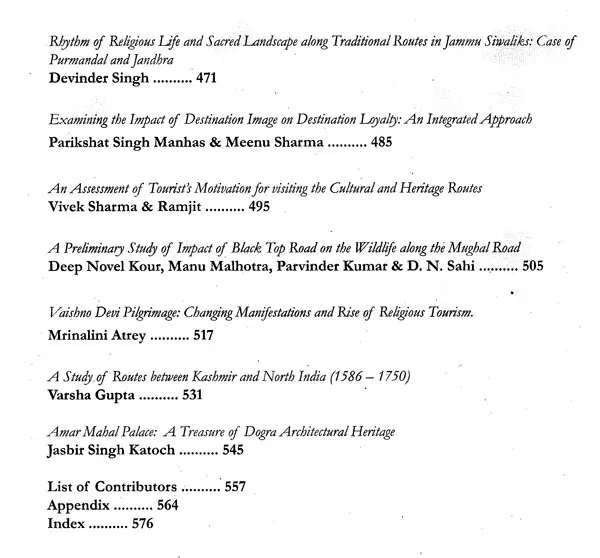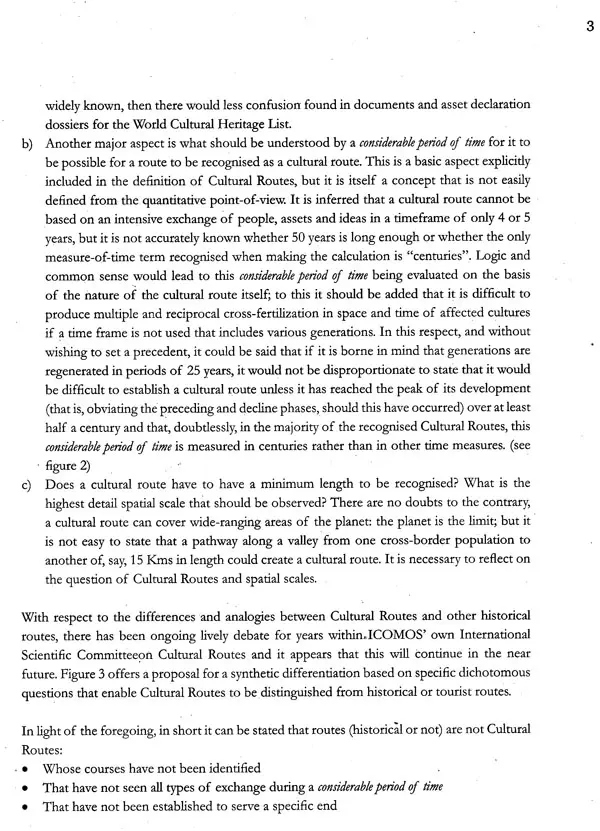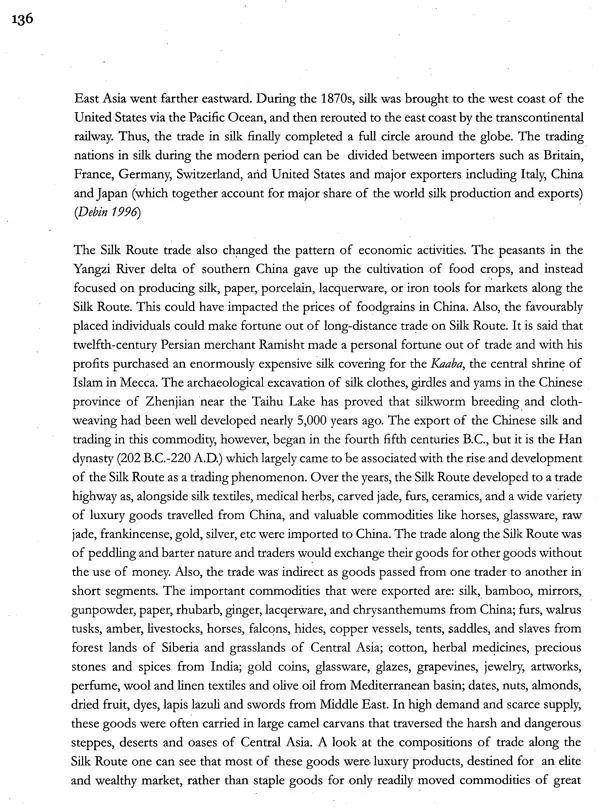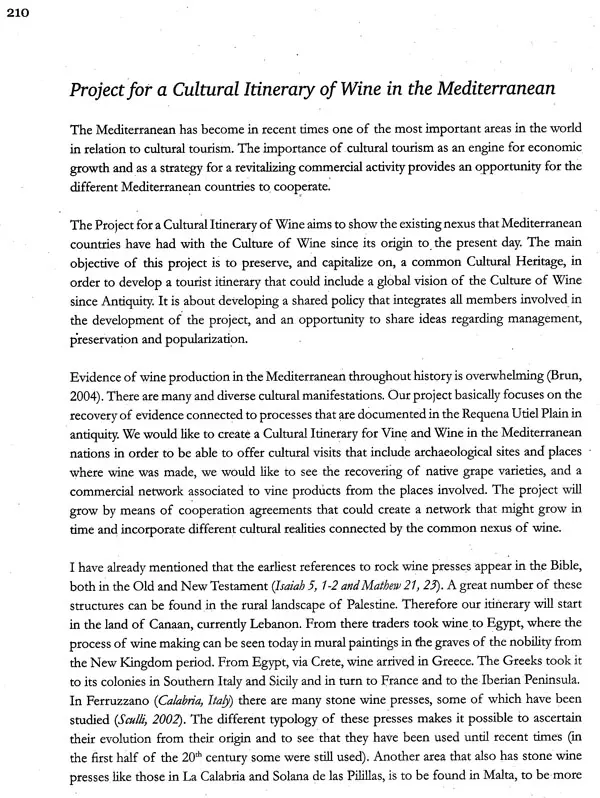
Heritage and Cultural Routes : An Anthology (Global Cultural Routes : Tourism and Socio - Economic Viability)
Book Specification
| Item Code: | UAE304 |
| Author: | Poonam Chaudhary |
| Publisher: | Shubhi Publications, Gurgaon |
| Language: | English |
| Edition: | 2012 |
| ISBN: | 9788182901414 |
| Pages: | 580 (Throughout B/W Illustrations) |
| Cover: | HARDCOVER |
| Other Details | 11.00 X 9.00 inch |
| Weight | 2.11 kg |
Book Description
Heritage and Cultural Routes: An Anthology, a peer-reviewed book, presents diverse and refreshing insights on a wide range of aspects pertaining to global cultural routes and heritage studies. The book provides a forum to stimulate discussion on emerging issues central to heritage management from historical, managerial as well as conservation perspective. The main focus has been to kindle research in such areas, which are vital and largely neglected. The potential readers and stakeholders may come across useful texts delineating new research areas of learning.
Dr. Poonam Chaudhary, a historian and a museologist, is a Professor and Director at the Center for Studies in Museology and Heritage Studies in the University of Jammu. She is widely travelled and has wide experience in the field of Heritage Studies. She has authored monographs, research papers and a book in the field of Cultural Heritage. Presently she is engaged in identifying and documenting the Cultural Routes of Jammu and Kashmir, especially, the Mughal Route.
This anthology on 'Heritage and Cultural Routes' brings together in one edited volume interdisciplinary explorations on Cultural Routes and Heritage along the routes from leading international authorities from across the globe. The contributions of the ICOMOS-CIIC (International Scientific Committee on Cultural Routes) members is significantly important as many major issues regarding the concept of Cultural Routes and the Heritage along the routes has been discussed. Cultural Routes is a new category recognized by UNESCO as a part of World Cultural Heritage, and is not fully understood in India especially in Jammu and Kashmir. In order to have an understanding of the concept, an International Conference on "Global Cultural Routes-Tourism and Socio-Economic Viability" was organised in the Centre for Studies in Museology, University of Jammu, which resulted in presentations on varied aspects of Cultural Heritage, Cultural Routes and Perspectives on Sustainable Development.
The concept of 'Routes' or 'Cultural Itineraries' was first discussed by the expert meeting on "Routes as a Part of our Cultural Heritage" (Madrid, Spain, November 1994) and finally defined by the second expert meeting (Madrid, Spain, May 2003) on the basis of the doctrinal development carried out by the ICOMOS-CIIC (International Scientific Committee on Cultural Routes (1997-2002), according to which it is a concept in which mutual understanding, a plural approach to history and a culture of peace can operate. It is based on population movement, encounters and dialogue, cultural exchanges and cross-fertilization, which have space of time dimension.
In light of the above definition it has been realized that India, especially Jammu and Kashmir has many major ancient routes like the Silk Route, part of which passes through Kashmir and was used not only for trade purposes but also influenced cultural exchanges; the Salt Route or lavansarni route which was used to transport salt to Kashmir from Panjab salt ranges and which in the 17th century became famous as the Mughal Route and was used by the Mughals (who ruled India from 16th to 18th century) for visiting Kashmir in summers.
Since Jammu and Kashmir is situated mostly in the Himalayan Mountains, hence prior to the construction of Banihal Cart Road and Jehlum Cart Road, all its areas were connected by a network of routes or margs. These routes / margs were pony tracts carved out in the mountain ranges like the Karokaram, the Pir Panjal and the Shivaliks. These routes, thus, enable us to retrieve important information about the routes and their impact on the socio-economic, cultural and religious life of the people of the region. Another critical issue related to the heritage is the degradation of invaluable cultural landscape along these routes. Therefore, protection and promotion of these cultural heritage routes become a priority area which can be skillfully managed.
Papers in this book discuss a wide range of topics related to Cultural Routes and Heritage like Landscape and Heritage: Methodological Approaches in Cultural Routes; Cultural Routes and Historic Roads: Differences and Analogies; ReferenceTerms for Cultural Routes; Building a case for World Heritage Nomination: Mughal Route in Perspective; Trails of the Silk Road; Religious and Tourism Routes; Routes vis-vis sources of Economy and Sustainable Development; Identification, Recognition and Integration of new routes; Cultural Itinerary of goods with opening of the new avenues through ocean and air routes; Cultural Interaction and Post-colonial Developments; Conservation and Management etc. These contributions include articles from India, Spain, Australia, United States, Mexico, Italy, Romania, Greece, Costa Rica, Dubai, Lebanon, Vietnam and Malaysia.
I am deeply indebted to the Ministry of Culture and Ministry of Tourism (Government of India), Indian Council of Historical Research (ICHR), Department of Tourism, Government of Jammu and Kashmir, Jammu and Kashmir Bank, Jute Board of India and the University of Jammu for their financial support to the conference. I also wish to express my gratitude to the International Scientific Committee on Cultural Routes (CIIC of ICOMOS) without whose cooperation, it would not have- been possible to have papers on varied aspects of Cultural Routes.
I extend my thanks to the authors and reviewers for adhering to the deadlines and making this volume possible. I am also grateful to Professors G.M. Bhat, Anju Bhasin, Arvind Jasrotia, Alka Sharma and my colleagues Ginny Dogra, Dr. Mrinalini Atrey of the University of Jammu for their invaluable assistance during the editorial process of this book. My dear friends Arvind' Jasrotia, Alka Sharma and Ginny Dogra further helped in pointing out the errors and putting together the pages of the book.
I deeply appreciate the support provided by my family for the completion of the book specially my parents Sudershan Mahajan and Kanta Mahajan; my father-in -law Ramesh Chaudhary, whose blessings are always with me. My husband Chanakya for having faith in me, my children Sumedha and Mitakshara for looking after themselves while I was busy putting this book in place, my brother-in laws Anil Goswami and Atul Kuthiala for encouraging me and finally my brother Raju and -my sisters Neeru, Madhu, Binny and Geetika for believing in me.
I would like to express my sincere thanks to the Sir Dorabji Tata Trust for publication grant of the book.
I would also like to take this opportunity to thank the publishers for their painstaking efforts to make this Book a reality.
The views discussed in the book are purely the responsibility of the author.
Since time immemorial, human beings have travelled across the world, whether primitives before recorded history or after the great civilisation arose several thousand years ago. All civilisations have a history of travelling to other nations and receiving travellors. In due course the frequented routes came to be named, such as the famous Silk Route linking India with Central Asia, Tibet and mainland China. Recently as part of its activities in the field of World Cultural Heritage, UNESCO has recognised cultural routes as a new category, although this is still not widely known.
India has been on the crossroads of civilisation and there are many ancient routes, such as the Silk Route, the Salt Route and the Mughal Route in Jammu and Kashmir. Poonam Chaudhary, Director of the Centre for Studies in Museology in the University of Jammu, has put together a large number of Essays from around the world dealing with cultural and historical routes, which include several in India, and particularly in Jammu and Kashmir. I commend her for this useful publication which will help to popularise the concept of cultural routes in India and around the world.
**Contents and Sample Pages**























